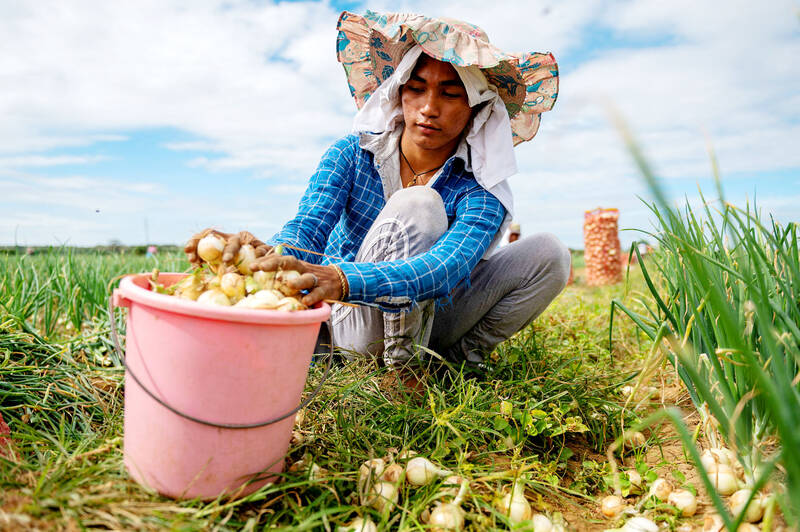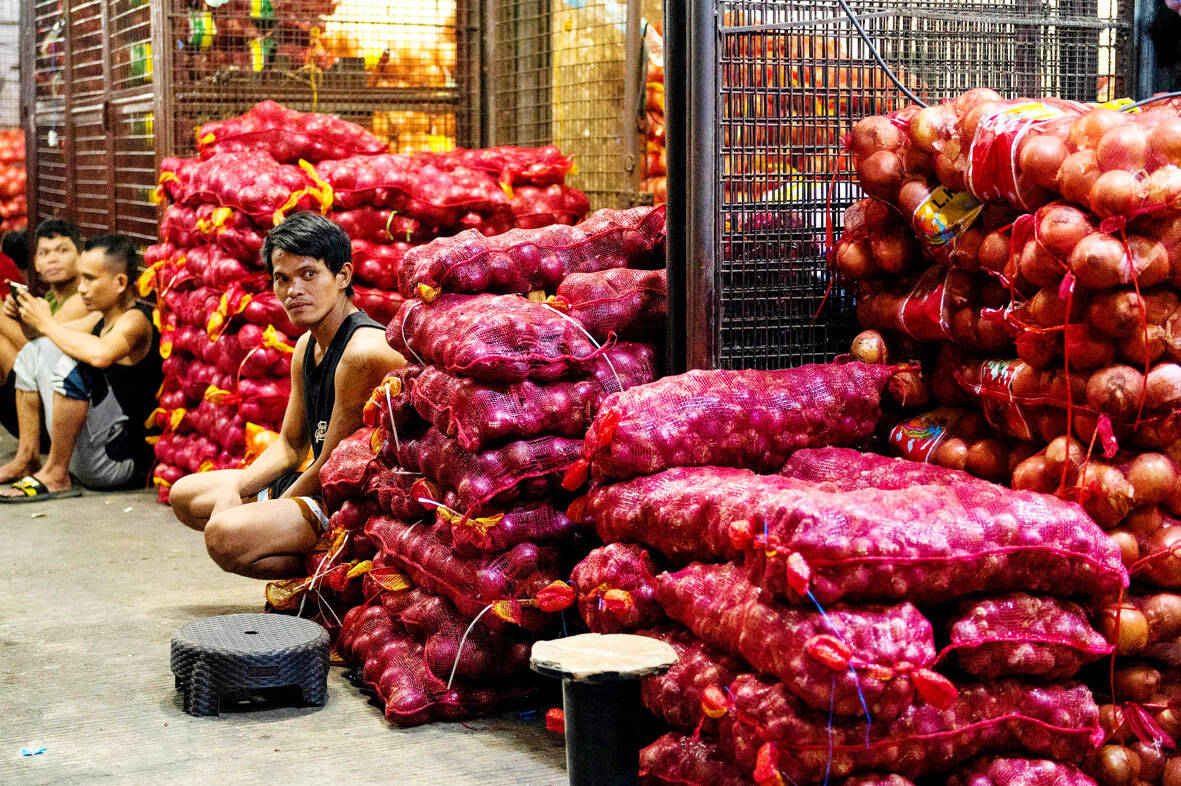Lalaine Basa would buy a kilo of onions to make spring rolls at her catering business north of Manila. She’s now changed her recipe to use half the amount because of soaring prices in the Philippines.
In the Moroccan capital Rabat, Fatima no longer buys onions and tomatoes because they are too expensive. She gets artichokes to cook tagine instead.
“The market is on fire,” said the mother of three.

Photo: REUTERS
The experiences of the two women more than 12,000km apart shows how the global crisis over food supplies is taking an alarming twist: threatening to consume ingredients critical to the world’s nutrition.
The costs of wheat and grains have fallenin recent months, easing concern over access to some staples. But a combination of factors is now shaking up the vegetable market, the backbone of a healthy, sustainable diet. And at the sharp end of that is the humble onion.
Prices are soaring, fueling inflation and prompting countries to take action to secure supplies. Morocco and Turkey have halted some exports, as has Kazakhstan. Restrictions have also gone beyond onions to include carrots, tomatoes, potatoes and apples, hampering availability worldwide, the UN and the World Bank warned this month.

Photo: REUTERS
RATIONING USAGE
In Europe, empty shelves have forced UK supermarkets to ration purchases of some fruit and vegetables after a weak harvest in southern Spain and North Africa.
“Simply having enough calories is not good enough,” said Cindy Holleman, a senior economist at the UN’s Food and Agricultural Organization in Rome. “Diet quality is a critical link between food security and nutrition. Poor diet quality can lead to different forms of malnutrition.”
Onions are the staple of cuisines across the world, the most consumed vegetable after the tomato (technically a fruit). About 106 million metric tons are produced annually — roughly the same as carrots, turnips, chillies, peppers and garlic combined. They’re used in everything from the base flavoring of curries and soups to fried toppings on hotdogs in the US, where futures trading in them has been banned since 1958 after an attempt to corner the market.
The jump in prices is a knock-on effect from disastrous floods in Pakistan, frosts damaging stockpiles in Central Asia and Russia’s war in Ukraine. In North Africa, meanwhile, farmers have battled severe droughts and an increase in the cost of seeds and fertilizers.
Poor weather has hit Moroccan growers particularly hard. At a market in the Ocean district in central Rabat, Fatima said vegetable prices remain “exuberantly high” even with the ban on sending onions and tomatoes to West Africa introduced by the government this month.
Clutching a bag of artichokes, the 51-year-old retired government worker said her earnings no longer last until the end of the month. That financial squeeze will be felt even harder during Ramadan, when Muslims traditionally break their daily fast with a large meal before celebrating the Eid holiday.
“We are eating more lentils, white beans and fava beans and soon we will settle for rice,” said Fatima, who declined to give her full name because of the political sensitivity in Morocco surrounding food inflation.
STRATEGIC STOCKPILES
Vegetable seller Brahim has been working in the Ocean market for over 30 years. Business has been slow, he said.
“I thought only single men bought vegetables by the piece,” said Brahim, 56. “Now, I bow my head when I see people who have been shopping at my stall for 10, 15, 23 years ask me in a broken voice for one tomato, one onion, one potato. People are at their limits.”
In the Philippines, a dearth of onions has compounded shortages of everything from salt to sugar over the last few months. Prices became so absurdly high that they briefly cost more than meat, while flight attendants were caught smuggling them out of the Middle East. The government of President Ferdinand Marcos Jr. has boosted imports to tame the highest inflation in 14 years.
“I just use the tiniest bits of onions,” said Basa, 58. Her almost three-decades-old business in Bulacan province caters for birthdays and weddings. “I have to adjust because I don’t want to raise prices too much and lose my customers.”
In Kazakhstan, the spike in prices has prompted authorities to tap strategic stockpiles while its trade minister urged people not to buy onions by the sack amid a panic rush to secure supplies in local supermarkets.
That’s on top of an export ban, also introduced in recent weeks by Kyrgyzstan, Uzbekistan and Tajikistan — the world’s top per-capita consumer thanks to onion-heavynational dish qurutob. Elsewhere, Azerbaijan is putting “limit” on sales and Belarus will license shipments.
NUTRITION TIME BOMB
As the cost of buying nutrient-rich vegetables and fruit soars and incomes struggle to keep up, healthy diets are getting out of reach. More than 3 billion people cannot afford a healthy diet, the most recent UN figures show.
That will rise up the political agenda globally, and nutrition will be a much more prominent part of government thinking, said Tim Benton, research director in emerging risks at Chatham House in London. He calls it a “nutrition time bomb” that’s exploding slowly.
“It’s not just teetering on the edge of famine in the Horn of Africa that should worry us about the current crisis,” he said. “It’s the widespread growth of poor nutrition. Nutrition was already startlingly bad on a global basis, beforehand.”
For now, while many governments will happily subsidize imports of wheat or flour to keep their people happy, there’s limited support for vegetable growers. The result is that the world produces too much starchy grains, sugar and vegetable oils than the nutritional needs, but only about a third of the fruit and vegetables needed, Benton said.
Like bread, onions also have shown the potential to ignite civil unrest. In India, which has banned exports on and off for years, high prices were cited for the Bharatiya Janata Party losing the vote in New Delhi in 1998. Two decades later, Prime Minister Narendra Modi, in his campaign to gain reelection, said farmers are his “TOP” priority, meaning the tomato, onion and potato.
“The major grains are really important from a kind of emblematic functioning of global food security and starvation,” said Benton. “But for many countries, it’s these additional things that matter when it comes to keeping the populace happy. This is in a sense the tip of the iceberg.”

On April 26, The Lancet published a letter from two doctors at Taichung-based China Medical University Hospital (CMUH) warning that “Taiwan’s Health Care System is on the Brink of Collapse.” The authors said that “Years of policy inaction and mismanagement of resources have led to the National Health Insurance system operating under unsustainable conditions.” The pushback was immediate. Errors in the paper were quickly identified and publicized, to discredit the authors (the hospital apologized). CNA reported that CMUH said the letter described Taiwan in 2021 as having 62 nurses per 10,000 people, when the correct number was 78 nurses per 10,000

As Donald Trump’s executive order in March led to the shuttering of Voice of America (VOA) — the global broadcaster whose roots date back to the fight against Nazi propaganda — he quickly attracted support from figures not used to aligning themselves with any US administration. Trump had ordered the US Agency for Global Media, the federal agency that funds VOA and other groups promoting independent journalism overseas, to be “eliminated to the maximum extent consistent with applicable law.” The decision suddenly halted programming in 49 languages to more than 425 million people. In Moscow, Margarita Simonyan, the hardline editor-in-chief of the

Six weeks before I embarked on a research mission in Kyoto, I was sitting alone at a bar counter in Melbourne. Next to me, a woman was bragging loudly to a friend: She, too, was heading to Kyoto, I quickly discerned. Except her trip was in four months. And she’d just pulled an all-nighter booking restaurant reservations. As I snooped on the conversation, I broke out in a sweat, panicking because I’d yet to secure a single table. Then I remembered: Eating well in Japan is absolutely not something to lose sleep over. It’s true that the best-known institutions book up faster

Though the total area of Penghu isn’t that large, exploring all of it — including its numerous outlying islands — could easily take a couple of weeks. The most remote township accessible by road from Magong City (馬公市) is Siyu (西嶼鄉), and this place alone deserves at least two days to fully appreciate. Whether it’s beaches, architecture, museums, snacks, sunrises or sunsets that attract you, Siyu has something for everyone. Though only 5km from Magong by sea, no ferry service currently exists and it must be reached by a long circuitous route around the main island of Penghu, with the